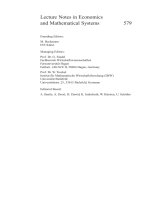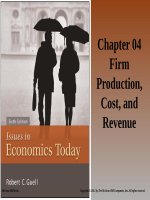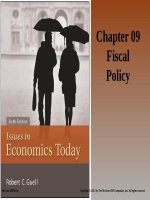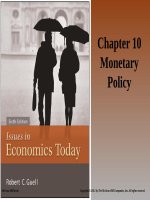Lecture Issues in economics today - Chapter 28
Bạn đang xem bản rút gọn của tài liệu. Xem và tải ngay bản đầy đủ của tài liệu tại đây (127.82 KB, 12 trang )
Chapter 28
Head Start
McGrawHill/Irwin
© 2002 The McGrawHill Companies, Inc., All Rights Reserved.
Chapter Outline
•
•
•
•
HEAD START AS AN INVESTMENT
THE HEAD START PROGRAM
THE CURRENT EVIDENCE
THE OPPORTUNITY COST OF FULLY
FUNDING HEAD START
McGrawHill/Irwin
© 2002 The McGrawHill Companies, Inc., All Rights Reserved.
The Head Start Program
• Head Start is an enhanced pre-school
program for poor children.
• It began in 1965.
• It enrolls nearly 1 million children per
year.
• Its budget is approximately $4 billion per
year.
McGrawHill/Irwin
© 2002 The McGrawHill Companies, Inc., All Rights Reserved.
Head Start as an Investment
• The premise of Head Start was that early
intervention with education for both parents
and children would pay for itself in future
years as the enrolled children would become
better adults. Specifically, the thought was
that they would be
– More likely to graduate from high school.
– Less likely to be imprisoned.
– More likely to delay having children.
McGrawHill/Irwin
© 2002 The McGrawHill Companies, Inc., All Rights Reserved.
Present Value Analysis
• Using present value analysis we must
account for the fact that the costs of the Head
Start program occur substantially prior to the
onset of financial benefits.
• If it can be shown that Head Start has all of
the benefits just listed, that is not enough.
• The present value of the benefits (the
reduction in prison costs plus the increase in
taxes paid by former enrollees) must exceed
the present value of the cost.
McGrawHill/Irwin
© 2002 The McGrawHill Companies, Inc., All Rights Reserved.
The External Benefits
Argument
• If there are benefits to preschool for
poor children that accrue to the general
population there is a positive externality
and a market will produce an
inefficiently low amount.
• Generally, when there is a positive
externality to any good, economists
favor subsidies for it.
McGrawHill/Irwin
© 2002 The McGrawHill Companies, Inc., All Rights Reserved.
The Early Evidence
• Studies from the 1980s showed that children
of the 1960s who were given high quality
preschool had significantly
– Lower rates of imprisonment.
– Higher rates of educational attainment.
• These studies showed that every $1 spent on
high quality preschool returned $5 later on in
higher tax revenues and lower tax
expenditures on crime.
McGrawHill/Irwin
© 2002 The McGrawHill Companies, Inc., All Rights Reserved.
Doubts
• Doubts were raised as to the quality and
reliability of these studies. Specifically it
was doubted that
– part-time preschool could overcome the
effects of poverty.
– the results could be duplicated in a
government program because of the nearideal nature of the study group.
McGrawHill/Irwin
© 2002 The McGrawHill Companies, Inc., All Rights Reserved.
The Program
• Enrolls nearly 1 million children.
– The population mirrors the poor population so it is
disproportionately minority.
• Costs $5,000 per child enrolled.
• Is not fully-funded (there are not enough
spots to offer Head Start to all who are
eligible.)
• Spending has been greatly increased since
1990.
McGrawHill/Irwin
© 2002 The McGrawHill Companies, Inc., All Rights Reserved.
E n r o llm e n t in 0 0 0
Head Start
Real Spending and Enrollme
3000
2500
2000
1500
1000
500
0
1966
1969
1972
1975
1978
1981
1984
1987
1990
1993
1996
Year
Enrollment
McGrawHill/Irwin
Real Appropriation
© 2002 The McGrawHill Companies, Inc., All Rights Reserved.
Evidence that Head Start is
Ineffective
• Many studies conducted over the last
20 years have failed to find a significant
link between Head Start participation
and any of the long term variables.
• These studies find that all the benefits
that accrue to participants dissipate
after 3rd grade.
McGrawHill/Irwin
© 2002 The McGrawHill Companies, Inc., All Rights Reserved.
The Opportunity Cost Question
• If the Head Start program cannot show
significant long term benefits, then the
opportunity cost of money spent is that:
– the money cannot be spent on other
programs.
– policy makers fail to consider other
programs.
McGrawHill/Irwin
© 2002 The McGrawHill Companies, Inc., All Rights Reserved.









